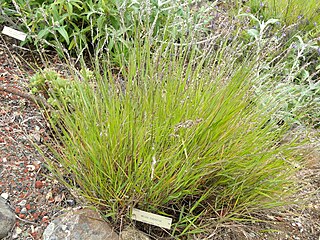Melica argyrea is a species of grass found in Argentina, Brazil, and Uruguay.

Melica amethystina is a grass species in the family Poaceae that can be found in southern Europe.
Melica argentata is a species of grass endemic to Chile.
Melica animarum is a species of grass that is endemic to Sierra de las Ánimas in Uruguay.
Melica longiflora is a grass species in the family Poaceae that is endemic to Chile where it can be found from Coquimbo to Talca.

Melica violacea, is a species of grass in the family Poaceae endemic to Chile.

Melica teneriffae, is a grass species in the family Poaceae that is endemic to the Canary Islands.
Melica porteri, known as Porter's melicgrass, is a species of grass that grows in the United States and Mexico. In the US it is found in Arizona, Colorado, Kansas, New Mexico, Texas, Utah, and Iowa.
Melica stuckertii, is a grass species in the family Poaceae that is endemic to Argentina and southern South America.
Melica scaberrima, is a species of grass that can be found in Yunnan, China, Nepal, Pakistan and northern part of India.
Melica eremophila is a species of grass that is native to South America.
Melica commersonii is a species of grass endemic to Chile.
Melica hyalina is a species of grass found in Brazil and southern South America.
Melica glabrescens is a species of grass found in Buenos Aires and Río Negro, Argentina.
Melica decipiens is a species of grass that can be found in the mountains of Cordoba and San Luis provinces of Argentina.
Melica lilloi is a species of grass found in Catamarca and Tucumán provinces of Argentina at 3,200–3,500 metres (10,500–11,500 ft) above sea level.
Melica paulsenii is a species of grass endemic to Chile where it grows along the coastal cordillera at 50–700 metres (160–2,300 ft) above sea level.
Melica rigida is a species of grass found in Argentina, Brazil, and Uruguay.
Melica patagonica is a species of grass that is endemic to South America.
Melica parodiana is a species of grass found in Buenos Aires, Argentina and Uruguay.


